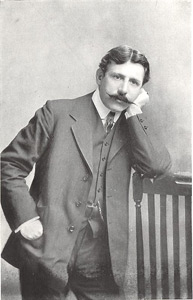The Mansfield mythBy Kristin PrestvoldThere are many stories and many opinions about the charismatic leader of the Northern Exploration Company Ltd. (NEC), Ernest Richard Mansfield. He became legendary in Svalbard during the first decades of the 20th century. On behalf of the NEC he annexed large areas, especially on the west coast of Spitsbergen. 
Very few people, if any, got as much attention as the founder of Ny-London during this historical era in Svalbard. To some he was a saint, to others a swindler. He was very popular amongst his workers and the overwintering trappers who guarded the installations in winter. Their stories tell about his benevolence and generosity, and his ability to make the workers and assistants feel well. The trapper Henry Rudi said about Mansfield: “During the time we spent with Mansfield we studied him thoroughly. Was he an explorer? Was he a swindler? No! Had he been that, we would have revealed it. He was a gentleman and a wonderful person to meet for poor trappers”. In his short career in the company he established, he occupied areas from Hornsund in the south to Krossfjorden in the north. All areas where commercially valuable minerals might be found were of interest. Sometimes he bought or annexed areas without prospects, like Camp Smith, with the house Giæverhuset, in Recherchefjorden. Bellsund was the NEC’s main area for a few years. Camp Morton was established here to exploit coal, Camp Asbestos was established to exploit asbestos, Iron Mountain Camp to exploit iron – and so on. In the north he established Ny-London in Kongsfjorden with the intention of extracting marble. Along the west coast of Spitsbergen there are cabins in various states of repair that were built by, on behalf of or with funding from Mansfield and the NEC. Mansfield was born in London in 1862. As a young man he showed an interest in mineral prospecting. He tried his luck as a gold digger both in Klondike and in British Colombia during the big gold rush, and also in Australia and New Zealand. Around the turn of the century he returned to England, married and had a daughter – Zoë. Here he met Frederic Gardner, the local pastor, who had been to Svalbard and found gold! It did not take much to persuade Mansfield to try his luck there and in 1905 and in 1906 the two men travelled together north to Svalbard to search for gold and other valuable minerals. In the following years Mansfield visited Svalbard many times. He overwintered in 1908-1909, during which he wrote a pulp fiction novel with a woman as his main character: Astria: the Ice Maiden (1910). Mansfield was the NEC. Despite this, after the “marble fiasco” at Blomstrandhalvøya, he was removed from the leadership of the company in 1913. After that he had nothing more to do with the company. Ernest Mansfield had an artistic mind and lots of charisma. He was a dreamer with ambitious goals, and a sincere wish for the big discovery. The dream was shattered, the marble at Blomstrandhalvøya crumbled in his hands, but the memories of this man and the remains of his brash endeavours live on in Ny-London and other places on Svalbard. Updated May 2015 |
The Cruise Handbook is also available in book formHard cover with numerous pictures - 249 pages - NOK 249.00 Norwegian Polar Institute |
 Norsk
Norsk